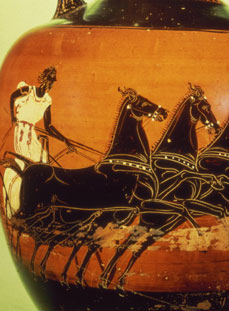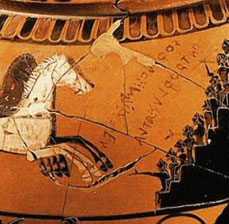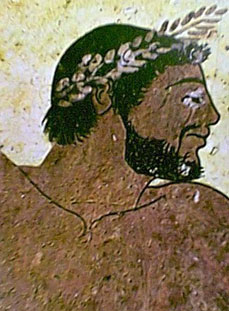
PANATHENAEA : EQUESTRIAN CONTESTS
If prizes are the criterion, the equestrian competitions were the most prestigious. Because of the expense involved in equipping and sponsoring a team of horses, only the wealthy could afford to compete. The rich Athenian aristocrat Alkibiades entered seven chariot teams in the Olympics of 4r6 B.C., three of them finishing first, second, and fourth
The equestrian contests at the Panathenaia were organized into two parts, one comprising three events open to all comers, the other composed of seven to ten events restricted to Athenians. The open events consisted of a thoroughbred race, a twohorse sulky race, and a four horse chariot race (the tethrippon). Each of these events had two divisions, one for young horses and one for those fully grown. In the pictorial evidence the jockeys are shown as nude youths, but the charioteers are bearded and wear long gowns. Most often the participants, who braved the dangers of riding bareback (without stirrups) or of maneuvering a light chariot around tight, congested turning posts, were not awarded the prizes. They went to the horses' owners, who were often foreign royalty and, in some instances, women.
The equestrian competitions restricted to Athenians had a more military flavor, such as throwing the javelin at a target from horse back. The precise events varied but always included war and parade chariots and climaxed, as though in a grand finale, with flat-out races for the two-horse sulky.

SPECIAL EQUESTRIAN CONTESTS
The Agora was the venue for some unusual, time-honored equestrian displays. The apobates harks back to the time when men dashed into battle on chariots, leapt off the moving vehicle, and later jumped back on board. Images of this contest, such as that on a victory monument set up in the Agora in the 4th century B.C., show warriors, armed with helmets and shields, perched on the backs of their racing chariots in what appears to be a dangerous demonstration of athletic prowess. The orator Demosthenes called it "the noblest and grandest of competitive exercises."
In the late-5th and 4th centuries B.C. the Athenian cavalry developed into an elite corps of 1.000 troops. Its impact on the Panathenaic program is evident in the event known as the anthippasia. This was a mock cavalry battle in which two squadrons of five regiments each (together representing the ten Athenian tribes) charged at top speed and rode through one another. Although this event took place in the hippodrome, a victory monument was set up in the Agora, in one instance by the winning tribe Leontis, as indicated by the lion and inscription on the reverse of the monument.

TRIBAL EVENTS
The cavalry display was one of a number of events in which participation was restricted to members of the ten Athenian tribes; in this regard the Panathenaia was unique among Panhellenic games.These tribal units were established by the democracy in 508 B.C., and the tribal competitions were no doubt instituted as a means of fostering one's identity with a tribe, much like what happens between local sports teams and their fans today. This building of group solidarity among the boys and young men of the tribes would have paid off when they joined their military units, which were organized by tribe.
Boys, youths, and men performed in separate contests of the pyrrhike. According to legend, Athena performed this dance when she was victorious over the Giants, and, like their patron goddess,these dancers wielded a spear and round shield. Plato (Laws 7.815a) describes their movements, which were performed to the accompaniment of the double-pipe: "It consists in imitating, on the one hand, movements that evade all kinds of blows and missiles by leaning to one side, giving way completely, jumping up high or dipping low then again striving to imitate the opposites to these, aggressive postures involved in striking with missiles arrows and javelins and with all sorts of blows." A 4th-century B.C. relief represents just such a synchronized military dance.
One of the least understood tribal contests is that concerning euandria, or manly excellence. It seems to have been some sort of team event involving beauty, size, and strength, but as yet we have no definitive representations of it in Greek art. Another team event was the "contest of ships," probably a boat race in the harbor at Piraeus.
